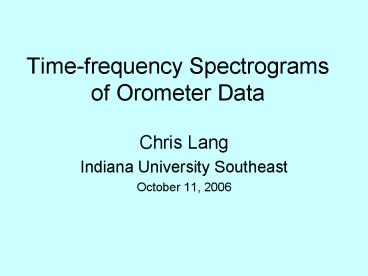Timefrequency Spectrograms of Orometer Data - PowerPoint PPT Presentation
Timefrequency Spectrograms of Orometer Data
... of sucking as it changes over time. Irregularity in sucking, visible as ... The sucking in this portion of the signal shows less regularity, so the lower ... – PowerPoint PPT presentation
Title: Timefrequency Spectrograms of Orometer Data
1
Time-frequency Spectrogramsof Orometer Data
- Chris Lang
- Indiana University Southeast
- October 11, 2006
2
What this analysis may show
- Frequency of sucking as it changes over time
- Irregularity in sucking, visible as low-frequency
harmonics - Jaggedness of sucks, visible as high-frequency
energy
3
Hai 5-4-06 1400 40-60s
- Strong, regular signal with energy concentrated
at about 1.3 Hz (a bit more than one suck per
second)
4
Sma 5-10-06 1500 20-40s
- This shows a change of frequency from above 2 Hz
down to 1 Hz
5
Mew 5-31-06 1730 (80-100sec)
- This shows a primary frequency of about 1.4 Hz
and a harmonic frequency of about half of that
(0.7 Hz), which occurs because the sucks tend to
alternate in amplitude (tallness)
6
Mew 5-31-06 1730 (140-160sec)
- The sucking in this portion of the signal shows
less regularity, so the lower frequency
information (below 1 Hz) is less concentrated.
7
DenB 4-17-06 1630 (80-100sec)
- This shows a noticeable amount of energy in
higher frequencies (above 2 Hz), which is due to
the jagged, irregular shape of the suck waveforms.
8
More concerning this analysis.
- Performed using a variant of Fourier analysis
known as continuous wavelet transform analysis
which is well-suited for this type of analysis. - For convenience and for more control, the graphs
and spectrograms were generated by software
written by the author but certain commercial
software programs also will draw similar
time-frequency spectrograms. - Acknowledgements Many discussions with Mr. Scott
Buckley have helped me understand what this
analysis might say about infant feeding. I am
also grateful to Scott for providing me with
Phase I and Phase II data.
PowerShow.com is a leading presentation sharing website. It has millions of presentations already uploaded and available with 1,000s more being uploaded by its users every day. Whatever your area of interest, here you’ll be able to find and view presentations you’ll love and possibly download. And, best of all, it is completely free and easy to use.
You might even have a presentation you’d like to share with others. If so, just upload it to PowerShow.com. We’ll convert it to an HTML5 slideshow that includes all the media types you’ve already added: audio, video, music, pictures, animations and transition effects. Then you can share it with your target audience as well as PowerShow.com’s millions of monthly visitors. And, again, it’s all free.
About the Developers
PowerShow.com is brought to you by CrystalGraphics, the award-winning developer and market-leading publisher of rich-media enhancement products for presentations. Our product offerings include millions of PowerPoint templates, diagrams, animated 3D characters and more.































